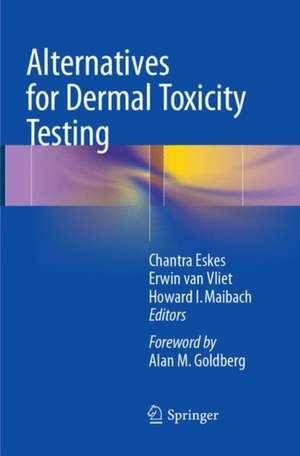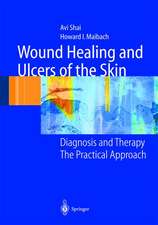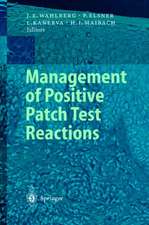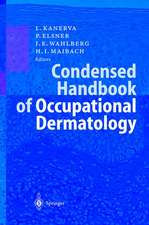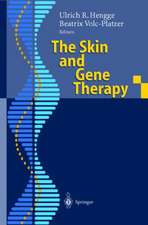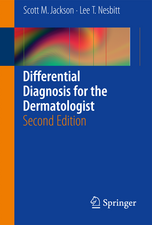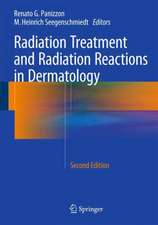Alternatives for Dermal Toxicity Testing
Editat de Chantra Eskes, Erwin van Vliet, Howard I. Maibachen Limba Engleză Paperback – 30 aug 2018
| Toate formatele și edițiile | Preț | Express |
|---|---|---|
| Paperback (1) | 802.21 lei 38-44 zile | |
| Springer International Publishing – 30 aug 2018 | 802.21 lei 38-44 zile | |
| Hardback (1) | 1132.31 lei 38-44 zile | |
| Springer International Publishing – 13 dec 2017 | 1132.31 lei 38-44 zile |
Preț: 802.21 lei
Preț vechi: 844.43 lei
-5% Nou
Puncte Express: 1203
Preț estimativ în valută:
153.52€ • 158.60$ • 127.77£
153.52€ • 158.60$ • 127.77£
Carte tipărită la comandă
Livrare economică 21-27 martie
Preluare comenzi: 021 569.72.76
Specificații
ISBN-13: 9783319843780
ISBN-10: 3319843788
Pagini: 592
Ilustrații: XX, 592 p. 92 illus., 61 illus. in color.
Dimensiuni: 155 x 235 mm
Ediția:Softcover reprint of the original 1st ed. 2017
Editura: Springer International Publishing
Colecția Springer
Locul publicării:Cham, Switzerland
ISBN-10: 3319843788
Pagini: 592
Ilustrații: XX, 592 p. 92 illus., 61 illus. in color.
Dimensiuni: 155 x 235 mm
Ediția:Softcover reprint of the original 1st ed. 2017
Editura: Springer International Publishing
Colecția Springer
Locul publicării:Cham, Switzerland
Cuprins
Introduction.- Concepts.- Skin irritation.- Skin corrosion.- Skin sensitization.- UV-induced effects (phototoxicity & photoallergy).- Skin genotoxicity.- Other exploratory areas of relevance.
Notă biografică
Chantra Eskes, PhD, Eng, has around 20 years of experience in the development, optimization, and validation of alternative methods to animal testing. Her activities have contributed to the formal validation and regulatory acceptance of several test methods and to the development of a number of official international test guidelines. Dr. Eskes acts as a Nominated Expert and co-chair for the OECD in the areas of eye irritation/corrosion, skin irritation, skin corrosion, and skin sensitization. She is also President of the European Society of In Vitro Toxicology (ESTIV) and Executive Secretary of the Animal Cell Technology Industrial Platform (ACTIP). She is manager and consultant at SeCAM, a limited company that offers independent consultation and services on alternative methods for scientific, regulatory, and industrial tailored requirements. She is the editor, author, or co-author of more than 35 published scientific articles and book chapters and acts as a reviewer for sever
al journals in the field of in vitro toxicology.Howard I. Maibach, MD, is Professor of Dermatology in the School of Medicine, University of California, San Francisco. He is a leading authority in the fields of dermatotoxicology and dermatopharmacology, in which, over several decades, he has conducted much original research relating to skin diseases and the development of skin-related products. He has written very extensively, with a total of more than 2,000 publications as lead or co-author and over 80 textbooks. Professor Maibach has served on the editorial boards of more than 30 scientific journals and is a member of many professional societies, including the American Academy of Dermatology and the International Commission on Occupational Health. He is a consultant to government agencies, universities, and industry. He has been the recipient of numerous honors, both in the United States and overseas.
Erwin van Vliet, PhD, has more than10 years of research experience during which he has acquired a strong scientific background in the field of in vitro toxicology. He has been involved in the writing and management of European research projects and formal validation studies. Dr. van Vliet worked for several years at EURL ECVAM in Italy and then gained professional experience at the Johns Hopkins Center for Alternatives to Animal Testing (CAAT) in Baltimore, USA, where he was responsible for setting up a new research laboratory and published a review article on toxicity testing for the 21st Century, awarded best main article by ALTEX. In 2010, he joined the Fetal Medicine Research Group in Barcelona,
Spain, and since 2013 he has worked as an independent consultant in the field of in vitro toxicology and alternative methods. He acts as the Scientific Coordinator of the Cosmetics Europe Skin Tolerance Task Force, which is developing a testing strategy for skin sensitization and supports various scientific projects of SeCAM.
al journals in the field of in vitro toxicology.Howard I. Maibach, MD, is Professor of Dermatology in the School of Medicine, University of California, San Francisco. He is a leading authority in the fields of dermatotoxicology and dermatopharmacology, in which, over several decades, he has conducted much original research relating to skin diseases and the development of skin-related products. He has written very extensively, with a total of more than 2,000 publications as lead or co-author and over 80 textbooks. Professor Maibach has served on the editorial boards of more than 30 scientific journals and is a member of many professional societies, including the American Academy of Dermatology and the International Commission on Occupational Health. He is a consultant to government agencies, universities, and industry. He has been the recipient of numerous honors, both in the United States and overseas.
Erwin van Vliet, PhD, has more than10 years of research experience during which he has acquired a strong scientific background in the field of in vitro toxicology. He has been involved in the writing and management of European research projects and formal validation studies. Dr. van Vliet worked for several years at EURL ECVAM in Italy and then gained professional experience at the Johns Hopkins Center for Alternatives to Animal Testing (CAAT) in Baltimore, USA, where he was responsible for setting up a new research laboratory and published a review article on toxicity testing for the 21st Century, awarded best main article by ALTEX. In 2010, he joined the Fetal Medicine Research Group in Barcelona,
Spain, and since 2013 he has worked as an independent consultant in the field of in vitro toxicology and alternative methods. He acts as the Scientific Coordinator of the Cosmetics Europe Skin Tolerance Task Force, which is developing a testing strategy for skin sensitization and supports various scientific projects of SeCAM.
Textul de pe ultima copertă
This book provides comprehensive information on the alternative (non-animal) dermal toxicity test methods currently available for industrial, regulatory, and academic use and also explores potential future developments. It encompasses all areas of dermal toxicity, including skin irritation, skin corrosion, skin sensitization, UV-induced effects, and skin genotoxicity. An individual chapter is devoted to each test method, with coverage of the scientific basis, validation status and regulatory acceptance, applications and limitations, available protocols, and potential role within testing strategies. In addition, perspectives from the test developer are presented, for example regarding critical steps in the protocol, possible adaptations, and challenges and opportunities. The closing section addresses exploratory areas that may be of relevance for the future of dermal toxicity safety testing, including the validation and regulatory acceptance of integrated testing strategies, the useof alternative methods for infections and inflammatory diseases, novel complex skin models, and high-throughput screening techniques.
Dermal toxicity is an area in which alternatives to the use of animal testing have already gained scientific, industrial, and regulatory acceptance. Practitioners and researchers alike will find Alternatives for Dermal Toxicity Testing to be an ideal source of reliable, up-to-date information on all aspects of the available test methods and likely future directions.
Dermal toxicity is an area in which alternatives to the use of animal testing have already gained scientific, industrial, and regulatory acceptance. Practitioners and researchers alike will find Alternatives for Dermal Toxicity Testing to be an ideal source of reliable, up-to-date information on all aspects of the available test methods and likely future directions.
Caracteristici
Provides in-depth information on the alternatives to animal testing Identifies the most suitable test method(s) for specific uses and endpoints Describes the regulatory acceptance, protocols, performance, limitations, and applicability of each method Explains the role of individual methods within testing strategies
